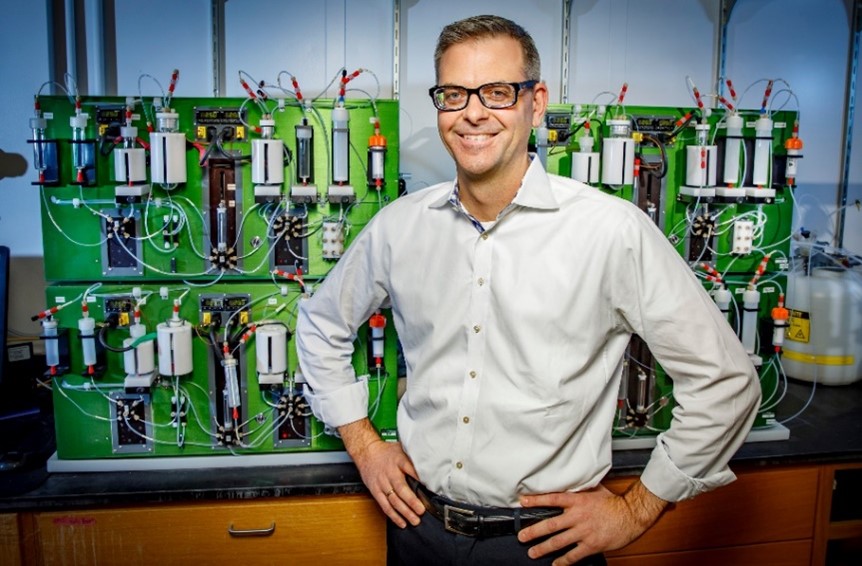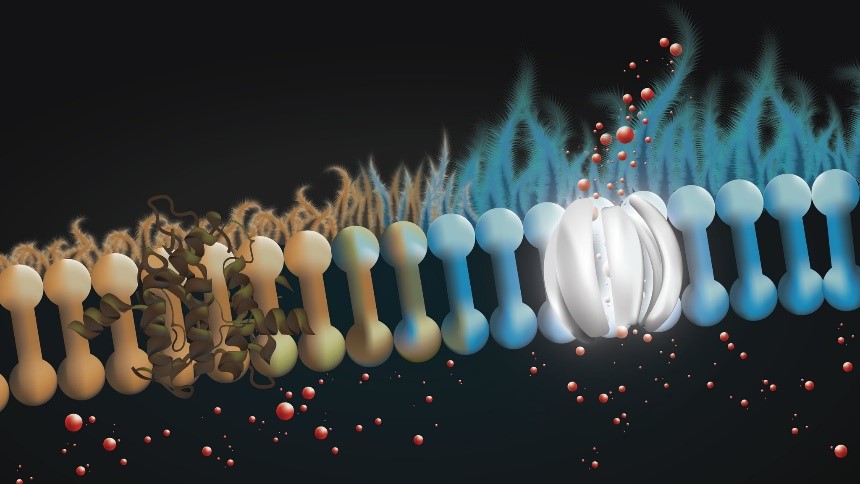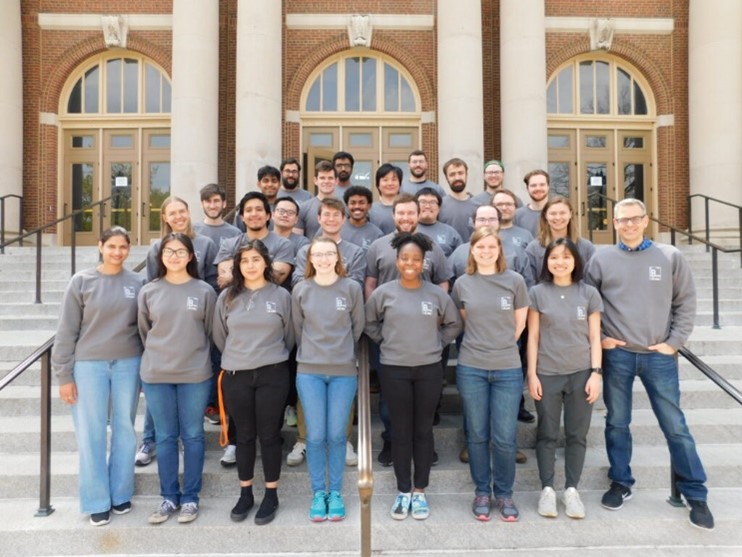As a medical student, Martin Burke, M.D., Ph.D., helped care for a young college student with cystic fibrosis (CF), an inherited disease that affects the body’s ability to make sweat and mucus. Dr. Burke had just studied CF in class, so he relayed what he had learned to her. He had a lot of information to give—doctors and researchers know the exact amino acid changes in an ion channel protein called cystic fibrosis transmembrane conductance regulator (CFTR) that cause CF.

“At one point in the conversation, she stopped me and said, ‘It sounds like you know exactly what’s wrong with me, so why can’t you fix it?’” Dr. Burke, now the May and Ving Lee Professor for Chemical Innovation at University of Illinois Urbana-Champaign (UIUC), never forgot this question. In fact, it’s inspired his career-long search for new ways to develop therapies for diseases without effective treatment options.
Doctor or Baseball Player
When he was a child growing up in Maryland, Dr. Burke dreamed of having one of two careers: doctor or baseball player. “The Orioles never called,” he says with a laugh, “but I was given the opportunity to go to Johns Hopkins University in Baltimore on a scholarship.” There, he studied chemistry on the premed track and was exposed to the potential of biomedical research in making a positive change in the world.
Combining that awe of the power of research with his desire to be a physician, Dr. Burke entered a dual M.D.-Ph.D. program at Harvard University in Cambridge, Massachusetts, funded by NIGMS. His Ph.D. project, under the mentorship of Stuart Schreiber, Ph.D., focused on developing new methods to create synthetic molecules with biological activity. Although Dr. Burke was interested in chemical synthesis, he became even more inspired by the idea that advances in the lab could lead to new medicines to treat diseases.
Modular Chemistry
After finishing his M.D.-Ph.D. training, Dr. Burke started his own lab at UIUC dedicated to small molecule synthesis. Many molecules that researchers want to test for biological activity, like natural products, are too complex to synthesize efficiently in the lab using traditional methods, which generally start with a small, basic molecule that researchers add onto step by step until the larger molecule is complete. To overcome this issue, he created a new type of synthesis called modular synthesis. Modular synthesis allows researchers to make molecules one building block at a time—which is easier than trying to make them in one long, linear sequence—and then piece the building blocks together using the same reaction over and over again. This method also gives researchers the power to tinker with the structure of naturally occurring molecules, adding or removing characteristics by changing the building blocks they use during synthesis, without having to start over at the beginning of a long sequence for each small modification.
Researchers around the world have used the modular synthesis technique for many applications, but Dr. Burke recognized that it could be used to help CF patients. So, with that “Why can’t you fix it?” question ever-present in the back of his mind, he set to work on developing a small molecule-based medicine for CF.
Building a Different Approach
A few different types of variants of the gene that codes for CFTR can cause CF. Some variants produce misshapen CFTR that can’t form a proper channel. Others trigger early termination of CFTR synthesis, resulting in a total loss of the protein. Since Dr. Burke started his research journey, medicines that help the protein fold properly have been introduced for patients with misshapen CFTR. However, there still aren’t any medicines for patients who lack CFTR altogether. In fact, missing or dysfunctional proteins cause many diseases for which there are no medicines that can turn on or replace the deficient protein functions.
Dr. Burke envisioned the creation of “molecular prosthetics” to help such patients. Like an arm or leg prostheses doing the job of a missing limb, a molecular prosthetic would perform the function of the missing protein. “Our dream was to find a small molecule that could self-assemble, form ion channels in lung cells (where CF has the biggest effect), and act as a replacement for the missing CFTR,” Dr. Burke says.

Rather than starting from scratch to design a molecule with these properties, Dr. Burke found inspiration from nature in amphotericin B (AmB), a naturally occurring molecule produced by bacteria that’s used to treat fungal infections. AmB forms ion channels in fungal and human membranes, making it a possible molecular prosthetic for CF. However, it’s also highly toxic to humans.
Refusing to let AmB’s toxicity dishearten him, Dr. Burke saw an opportunity to draw on the power of modular synthesis to better understand it. “We wanted to synthesize a version of AmB using modular chemistry that separates its toxicity from its ion channel forming activity,” he says.
Dr. Burke’s lab was able to do just that: create a modified version of AmB using modular synthesis. This version helped them understand that AmB’s toxicity comes from the way it binds sterols—a group of molecules that includes cholesterol. By precomplexing AmB with sterols, they were able to mask its toxicity without affecting its ion channel activity. They first tested this new strategy in cell culture. When they supplied yeast cells that couldn’t produce their own ion channels with sterol-complexed AmB, it replaced the important ion channel function in the cells over a wide range of doses. In collaboration with Michael Welsh, M.D., at the University of Iowa, they also ran similar experiments with human CF airway cells in cell culture and showed that AmB complexed with cholesterol reversed negative effects from the loss of CFTR, such as overly thick mucus. Because of these promising results, Dr. Burke’s AmB-cholesterol combination called amphotericin B cystetic for inhalation (ABCI) is now being tested in an early-stage clinical study as a potential therapeutic for CF.

“Excitingly, the same approach could potentially work for many diseases caused by loss of protein function. We’re learning more and more that small molecules can have all kinds of amazing functions, far beyond just binding to proteins and turning them off,” Dr. Burke says. His lab has also developed a molecular prosthetic to transport iron across membranes that could be used in cases of iron metabolism disorders caused by missing iron transporters. Dr. Burke is hopeful that even more chemists will adopt this approach to magnify its benefits to humankind.
Looking Forward
Dr. Burke believes that for new molecular approaches to have the greatest impact, the scientific community must welcome more researchers from diverse backgrounds to work on these techniques. “There are 8 billion people on our planet, and right now, those of us who get to meaningfully participate in molecular innovation could all fit in one building,” he says. “Eight billion imaginations—arguably one of our greatest natural resources—and we aren’t taking advantage of them to try to discover tomorrow’s medicines, materials, and all the other amazing roles that molecules fill to create the world around us.” When people with fresh ideas and new perspectives enter the field of chemistry, innovations are sure to follow.
Dr. Burke’s work is supported by the NIGMS Maximizing Investigators’ Research Award program through grant R35GM118185.







